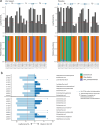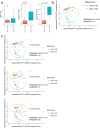Effects of Uro-Vaxom vs. placebo on the urinary tract microbiome in individuals with spinal cord injury in a randomized controlled pilot trial (Uro-Vaxom pilot)
- PMID: 40229352
- PMCID: PMC11997090
- DOI: 10.1038/s41598-025-96939-y
Effects of Uro-Vaxom vs. placebo on the urinary tract microbiome in individuals with spinal cord injury in a randomized controlled pilot trial (Uro-Vaxom pilot)
Abstract
Individuals with spinal cord injury/disease (SCI/D) have a high incidence of urinary tract infections (UTI). This randomized controlled pilot trial investigated the effect of an immunomodulator (Uro-Vaxom) versus a placebo on the urinary tract microbiome of individuals with SCI/D to inform the design of a larger trial. Twenty participants with SCI/D undergoing primary rehabilitation were randomized to receive either Uro-Vaxom or a placebo for three months (ClinicalTrials.gov NCT04049994 08/08/2019). Urine was collected at baseline, immediately post-treatment, and three months post-treatment. DNA was extracted and sequenced using full-length 16 S rRNA using Oxford Nanopore technology. Internal controls were added for absolute abundance estimation. There were 10 participants in Uro-Vaxom and 10 in placebo analyzed. The prevalence of Escherichia coli was lower in the Uro-Vaxom group (2/10) compared to the placebo group (5/10) post-treatment, although this difference was not statistically significant. Significant alpha and beta diversity differences were associated with the microbial load, sex, and voiding method. Uro-Vaxom showed potential in reducing E. coli prevalence during the treatment period, but this result requires validation in a larger trial. Future trials should consider the baseline microbial load and optimal timing of intervention to ensure that the observed effects are attributable to immunomodulation.
Keywords: Full length 16S rRNA; Immunomodulation; Spinal cord injury; Urinary tract infections; Uro-Vaxom.
© 2025. The Author(s).
Conflict of interest statement
Declarations. Competing interests: The authors declare no competing interests.
Figures





Similar articles
-
Immunomodulation for primary prevention of urinary tract infections in patients with spinal cord injury during primary rehabilitation: protocol for a randomized placebo-controlled pilot trial (UROVAXOM-pilot).Trials. 2021 Oct 4;22(1):677. doi: 10.1186/s13063-021-05630-w. Trials. 2021. PMID: 34607600 Free PMC article.
-
Uro-Vaxom® versus placebo for the prevention of recurrent symptomatic urinary tract infections in participants with chronic neurogenic bladder dysfunction: a randomised controlled feasibility study.Trials. 2019 Apr 16;20(1):223. doi: 10.1186/s13063-019-3275-x. Trials. 2019. PMID: 30992071 Free PMC article. Clinical Trial.
-
A Retrospective Study of Immunotherapy Treatment with Uro-Vaxom (OM-89®) for Prophylaxis of Recurrent Urinary Tract Infections.Curr Urol. 2020 Oct;14(3):130-134. doi: 10.1159/000499248. Epub 2020 Oct 13. Curr Urol. 2020. PMID: 33224005 Free PMC article.
-
Efficacy and Safety of Uro-Vaxom in Urinary Tract Infection Prevention: A Systematic Literature Review.J Clin Med. 2025 May 29;14(11):3836. doi: 10.3390/jcm14113836. J Clin Med. 2025. PMID: 40507598 Free PMC article. Review.
-
Vaccines for the prevention of recurrent urinary tract infections: a systematic review.BJU Int. 2019 May;123(5):753-768. doi: 10.1111/bju.14606. Epub 2018 Dec 19. BJU Int. 2019. PMID: 30378242
References
-
- Gao, Y., Danforth, T. & Ginsberg, D. A. Urologic management and complications in spinal cord injury patients: A 40- to 50-year Follow-up study. Urology104, 52–58 (2017). - PubMed
-
- Shekelle, P. G., Morton, S. C., Clark, K. A., Pathak, M. & Vickrey, B. G. Systematic review of risk factors for urinary tract infection in adults with spinal cord dysfunction. J. Spinal Cord Med.22 (4), 258–272 (1999). - PubMed
-
- Krebs, J., Wollner, J. & Pannek, J. Risk factors for symptomatic urinary tract infections in individuals with chronic neurogenic lower urinary tract dysfunction. Spinal Cord. 54 (9), 682–686 (2016). - PubMed
Publication types
MeSH terms
Substances
Associated data
Grants and funding
LinkOut - more resources
Full Text Sources
Medical
Molecular Biology Databases

